Intercom is a quietly MASSIVE hit:
- 17,000+ paying customers
- $50+ million in annual recurring revenue (ARR)
- Investments from the “who’s who” of investors (including Mark Zuckerberg, Jason Fried, and Jack Dorsey)
I asked Chris Von Wilpert, the brains behind Rocketship Agency, to be a marketing detective and figure out WTF marketing ideas they use to grow so quickly.
Today, Chris is going to show exactly how Intercom has grown from $0 to $50 million — and how you can use the same principles in your own business.
Take it away, Chris…
| BONUS: Get the 5-step checklist to Reverse Engineer Your Competitor’s Traffic & Conversion Strategy |
- [Tip #1] the Biggest Viral Marketing Hack You’ve Never Seen: “Powered by” plus Dynamic Keyword Insertion
- [Tip #2] Competitor Traffic Strategy: Steal Your Competitors’ Traffic With “Alternative” Landing Pages
- [Tip #3] Simple SEO Growth Strategy: Focus on Google Keywords That Will Bring You the Highest Number of Qualified Leads Using “The Core Problem Framework”
- [Tip #4] New, Brand-Building Content Strategy: Write Original, Thought-Provoking Branded Content to Get THOUSANDS of Shares Using “The Proven Topic Framework”
- [Tip #5] the Most Unusual Method for Converting Content into New Product Signups: “The next Step CTA Method”
- [Tip #6] Follow Intercom’s Simple Offsite Content Strategy to Get All Your Content Seen by a New Audience
- [Tip #7] Ultra-Granular Paid Search Strategy: Focus on High Buy Intent Keywords If You Want to Be Successful Without a Big Ad Budget
- [Tip #8] Advanced Landing Page Strategy: Convert Your Traffic into Customers by Matching Your Landing Page with One of the 5 Levels of Market Awareness
Intercom has grown from $1 million to $50 million annual recurring revenue (ARR) faster than other “big-name” SaaS startups including
- Shopify
- New Relic
- HubSpot
- Zendesk
- RingCentral
- Atlassian
![]()
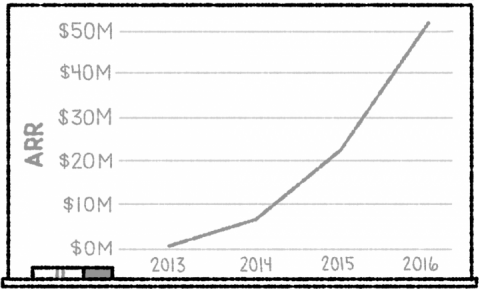
Here’s an even crazier fact: The only SaaS in history to grow faster is Slack.
Wow!
Best of all, Intercom has grown — and continues to grow — WITHOUT spending insane amounts of money on advertising or marketing.
This means you can do it for your business, too. Let’s get it on!
Traffic Sources Intercom Used to Build a $50M+ Brand
Intercom is a tool founded in California by Eoghan McCabe, Des Traynor, Ciaran Lee, and David Barrett in 2011. The tool’s goal is to help companies personalize, simplify, and organize their communication.
Here’s how Intercom gets most of their web traffic.

With an amazing blog, a select group of targeted paid keywords, and an advanced referral traffic strategy, it makes sense they have a very high amount of direct traffic.
Beyond direct traffic, Intercom gets the most traffic from search and referral.
To increase your own direct, search, and referral traffic, here are eight growth marketing ideas you can apply to your business.
[Tip #1] the Biggest Viral Marketing Hack You’ve Never Seen: “Powered by” plus Dynamic Keyword Insertion
Here’s a look at Intercom’s top referring sites.
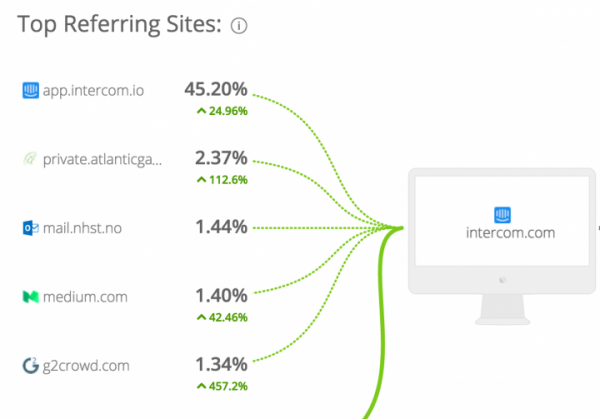
The number one referrer is from the Intercom app itself – most likely coming from the free trial or paying customers logged in to the app.
The other referrers are where it gets more interesting because of Intercom’s incredible “powered by” tactic. Let’s look at the 2nd referrer as an example.
First, we head to the Atlantic Global Asset Management page. Notice the personalized live chat box in the bottom right corner.
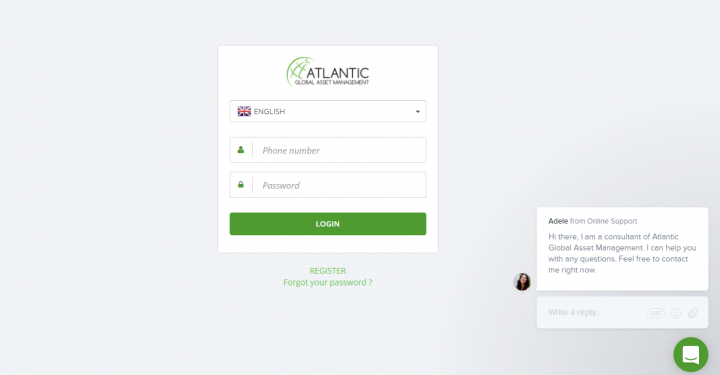
If I click the chat box, I’ll find an unobtrusive little message stating “We run on Intercom.”
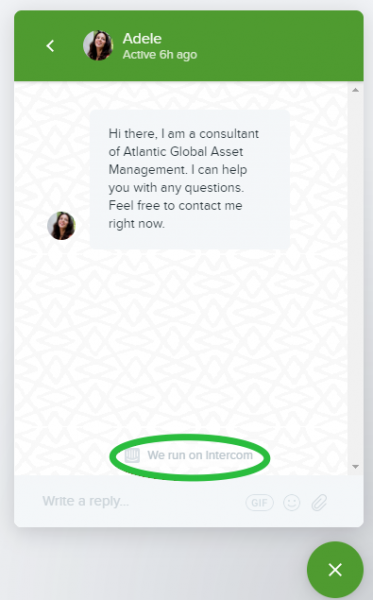
If I’m curious and want to learn more, I can click and I’ll be taken to a dedicated landing page Intercom has set up for people who come from the Atlantic Global Asset Management website.
This is what the landing page looks like (pay close attention to the headline):
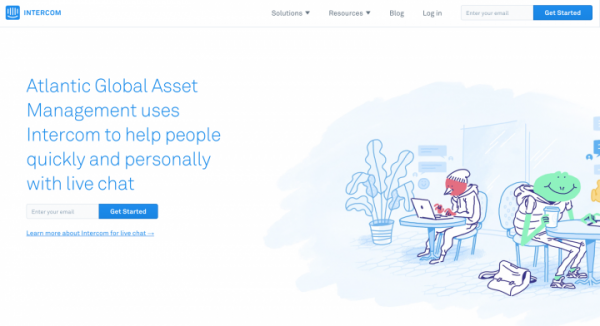
The team at Intercom uses dynamic keyword insertion in the headline to personalize the landing page experience for visitors based on the referring company.
They do this using a custom keyword variable in the URL. Here’s the exact URL for Atlantic Global Asset Management:
https://www.intercom.com/intercom-link?company=Atlantic%20Global%20Asset%20Management&solution=live-chat
You’ll notice Intercom is using a “company” parameter in their referral URL. Intercom combines the “powered by” tactic with dynamic keyword insertion to increase conversions from their referral traffic.
The takeaway: Identify marketing channels that are already working for you right now and look for ways to growth hack them to a whole new level.
[Tip #2] Competitor Traffic Strategy: Steal Your Competitors’ Traffic With “Alternative” Landing Pages
Drift (one of Intercom’s competitors), is on Intercom’s list of top 5 paid keywords.
Intercom has done enough research to know the type of people searching for Drift have certain needs. And Intercom can “intercept” those searchers and appeal directly to those needs to turn these people into customers.
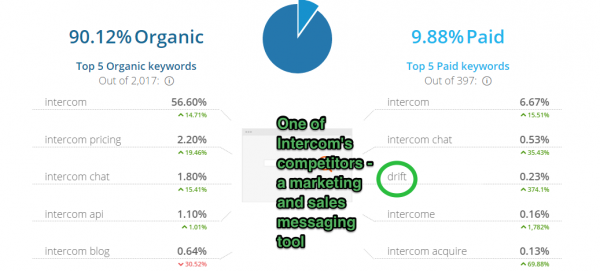
Here’s the paid ad Intercom uses to direct Drift branded traffic back to their website:

Specifically, Intercom sends people to their live chat landing page for Drift branded keyword traffic.
When you look at Drift’s top paid keywords, you can see that three of them are Intercom-based:
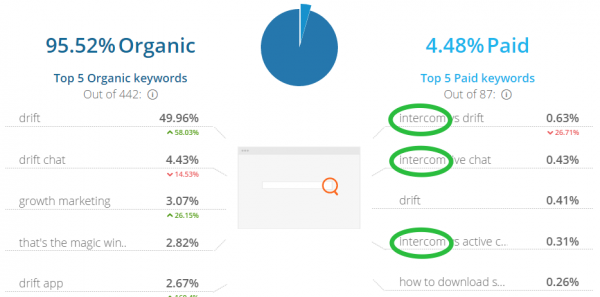
Drift isn’t just standing by, though.
They’re following a similar strategy to try and get people to switch from Intercom to Drift — but they’re taking it to a whole new level. Check out Drift’s “Intercom Alternative” landing page.
The Drift team is using this personalized landing page to try and convert Intercom customers into Drift customers.
Below is an example of one of the questions. Take note of how Drift uses question-based copy to tie into each of their unique selling points to try and convince people to switch from Intercom to Drift.
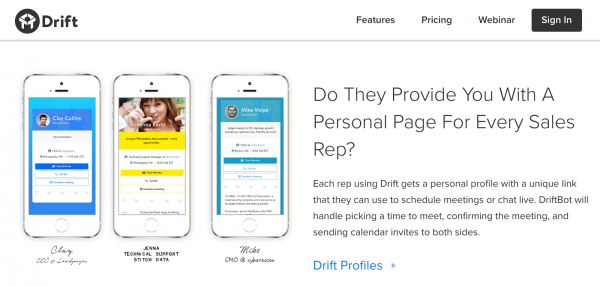
They even use their chat widget to link to a case study on their blog about why 15Five switched from Intercom to Drift (the first time you visit the page). Here’s what it looks like.
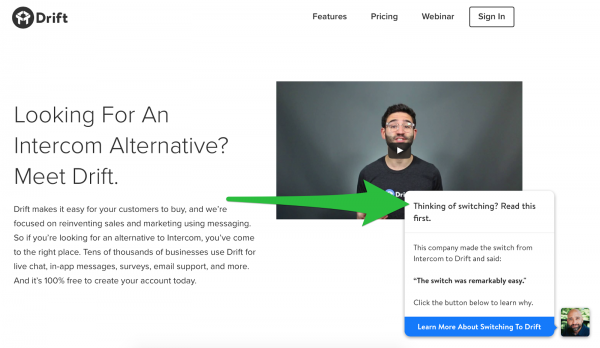
If you’re trying to compete against a major competitor, this is your David vs. Goliath opportunity to take them down using highly relevant, targeted marketing.
Bidding on competitors’ keywords isn’t cheap, especially when your competitors are bidding on their own branded keywords (like Intercom).
The takeaway here: Be aware of big competitors that may have a more enticing offer than your own and work to counter it (Intercom use the same strategy for Zendesk branded keywords, sending Zendesk branded keyword traffic to a dedicated Zendesk Alternative landing page).
[Tip #3] Simple SEO Growth Strategy: Focus on Google Keywords That Will Bring You the Highest Number of Qualified Leads Using “The Core Problem Framework”
Intercom has built their keywords and SEO presence by providing answers to core problems their target customers face every day. This has allowed them to achieve 2 specific goals:
- Build a trusted brand authority website
- Focus on Google keywords that will bring them the highest number of qualified leads
409 of Intercom’s 29,230 keywords on Google rank as first page results.
While the raw number of total organic keywords (409) may be on the low side, every keyword that ranks on the first page has one common theme.
Each piece of content solves one core problem.
Here’s a summary of some of their top organic keywords, ranked by keywords on the first page of Google with the highest average global monthly search volume:
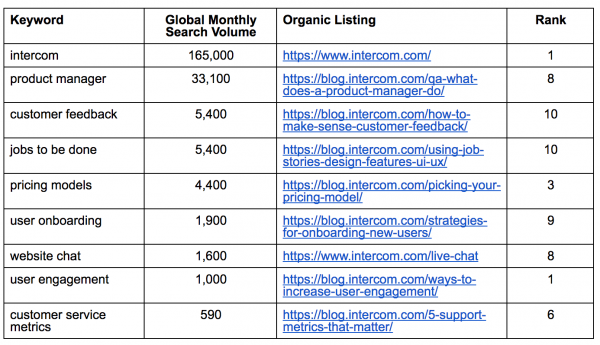
Intercom didn’t get these rankings by keyword-stuffing articles.
They got them by writing articles solving a real problem their target customer faces.
It’s what SEO experts call “Semantic SEO.”
| BONUS: Massively awesome SEO tips from my go-to SEO expert |
In other words, an article answering a question or search phrase, so even when the article doesn’t contain an exact match of the keyword, Google’s search algorithm is smart enough to interpret a searcher’s intent and show it to the user.
The takeaway here: With artificial intelligence in search evolving beyond “keywords”, using the “The Core Problem Framework” is a great long-term white hat SEO strategy that is proven to work.
[Tip #4] New, Brand-Building Content Strategy: Write Original, Thought-Provoking Branded Content to Get THOUSANDS of Shares Using “The Proven Topic Framework”

You may think that all of Intercom’s organic traffic just comes from their high ranking Google keywords in the last section, but that is not the case. Those “Semantic SEO” optimized articles are just one part of Intercom’s overall brand-building content strategy.
Intercom’s content strategy also includes original, thought-provoking branded content pieces that get thousands of shares (but you won’t find ranking anywhere on the 1st page of Google).
These original, branded content pieces are at the core of Intercom’s marketing and customer acquisition strategy.
Intercom’s content team has been blogging for close to 6 years to build their branded content, starting when Des Traynor posted their first article “Recent new features in Intercom” on October 6, 2011 (98 days after Intercom launched).
The branded content on their blog has helped the product rapidly grow so, it’s worth taking a look at some of their most shared posts.
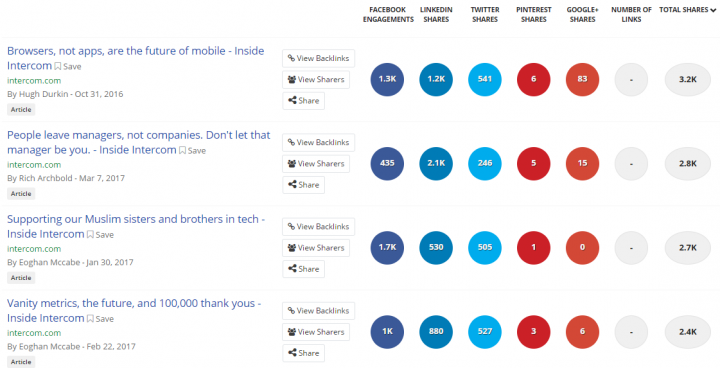
Let’s breakdown how each of these individual posts have become so popular…
This is Intercom’s most popular article that draws inspiration from a 2014 article with 4,700 shares on qz.com titled “Most smartphone users download zero apps per month”.
After drawing inspiration from that article and adding to the discussion, Intercom’s own article went viral on Hacker News with 185 comments:

Coming up with content topics like this comes from reading widely. This “Read widely” content tactic is tip #5 from Intercom’s Managing Editor, John Collins in his article from “How do you decide what to write?”
This is Intercom’s second most popular article that was published on March 7, 2017; however interestingly enough there was a post that went viral and made it to #1 on Hacker News on exactly the same topic over 4 years ago on February 7th, 2013:

Intercom leveraged the popularity of this #1 Hacker News post from over 4 years ago, drawing inspiration and adding to the debate.
Instead of leading with a story like the old Hacker News #1 article did, Intercom lead with data-backed evidence from a recent study to “move the conversation on.”
This smart “Move the conversation on” content tactic is tip #4 from Intercom’s Managing Editor, John Collins in his article on “How do you decide what to write?”
Intercom’s third most popular article is a direct response offer to help Muslims in the tech community relocate to Dublin (providing free relocation advice, a job opportunity in a Dublin tech company, legal bills up to €5k and an Intercom buddy program to explore Dublin).
This article was so widely shared because of the amazing offer Intercom made giving back, and expecting nothing in return. It also perfectly aligns with Intercom’s original vision, marketing strategy, and current solutions that are all based on one emphasis: Real, human connection.
This “Recycle content” content tactic is tip #1 from Intercom’s Managing Editor, John Collins in his article on “How do you decide what to write?”
Intercom’s fourth most popular article became so popular because it was their first public update from co-founder, Eoghan McCabe on Intercom’s growth since their last 4 rounds of funding.
In the post Eoghan reveals Intercom’s number of monthly active users, in-app conversations, revenue growth for the past 5 years, profitability and plans for future growth.
This “Expose your data” content tactic is tip #2 from Intercom’s Managing Editor, John Collins in his article on “How do you decide what to write?”
The takeaway here: There are many different ways to make your content viral. Pick a content marketing idea from Intercom’s content arsenal and write your own original, thought-provoking piece of branded content.
[Tip #5] the Most Unusual Method for Converting Content into New Product Signups: “The next Step CTA Method”
There are 2 elements that are uniform across all of Intercom’s blog posts:
- An author caricature. Keeping in-line with Intercom’s emphasis on real, human connection, you’ll find a small caricature of the author at the top of each and every post.
- A big, bold statement at the top of the page. All of Intercom’s blog posts begin with big, bold statements that capture the reader’s attention and gives them a hint as to what they’ll find if they keep reading.
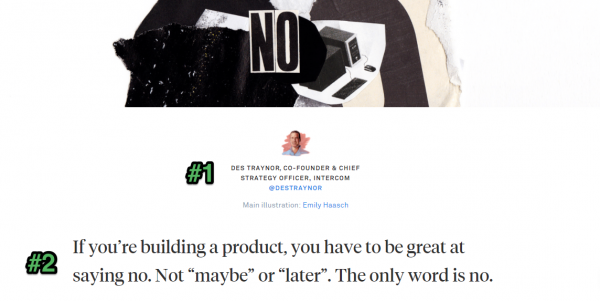
But arguably, one of the most interesting and unique aspects of Intercom’s blog posts is the final call-to-actions are very irregular.
At the end of a blog post for your average website, you can almost guarantee you’ll be bombarded with an annoying, brightly colored email sign-up box or sales push.
That’s not always the case with Intercom.
While some of Intercom’s articles do offer the expected lead magnet, the others vary quite a bit. See below:
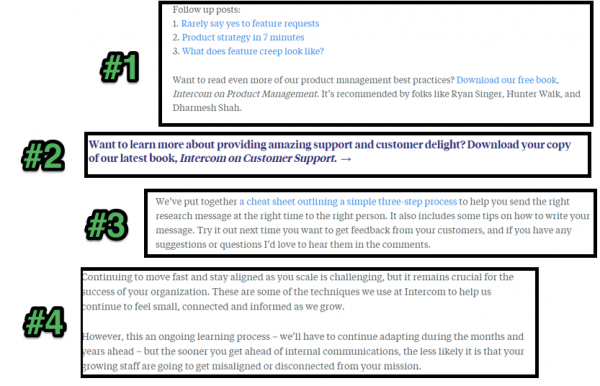
Here’s a quick breakdown of the CTAs from the image above:
- Free book download (Intercom on Product Management) in exchange for giving your email address
- Free book download (Intercom on Customer Support) in exchange for giving your email address
- Downloadable “cheat sheet” (Research Message Cheat Sheet) that readers can download without giving any contact info (this is an unusual tactic as it gives Intercom no way to continue nurturing these leads in the future)
- Post conspicuously absent of any type of call-to-action at all
Occasionally, I came across a CTA asking readers to join the free newsletter.
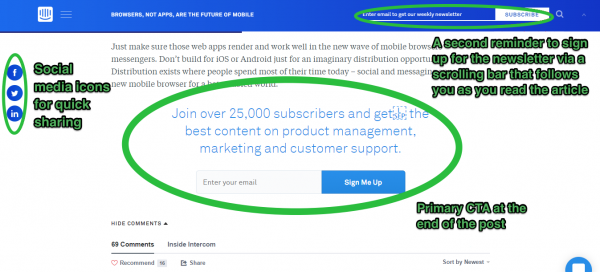
Of all the CTAs I saw on Intercom’s blog, the ones broadcasting the newsletter were the biggest and boldest (though compared to what you usually find on other websites, it really was neither big nor bold).
Even the weekly newsletter itself lacks any sort of the usual CTAs you would expect to see.
The lack of CTAs is likely a reflection of Intercom’s vision. As opposed to focusing on keyword-stuffed, lead generation obsessed articles, many articles operate from a foundation of strong, personal, genuine communication.
Here’s an example. This article is a visual representation of the company’s #1 goal: Clear communication and open dialogues.
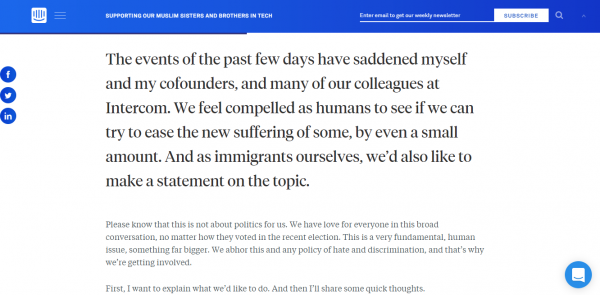
In some ways, perhaps creating articles without strong CTAs, annoying pop-ups, or aggressive “marketing speak” is one of Intercom’s ways of showing its customers that it hasn’t given up on its original vision of authentic connection.
In other words, this could be a beneficial way to strengthen customer trust and improve perception of the company as a whole.
The takeaway here: Think about what the most logical next step is for someone to take after reading your content piece and use that as your CTA. Is it to download your book, download a cheat sheet, sign-up for your newsletter or something else?
[Tip #6] Follow Intercom’s Simple Offsite Content Strategy to Get All Your Content Seen by a New Audience
To increase the traffic, reach and engagement for each of their blog posts, Intercom set up a Medium publication called Inside Intercom (to match the branding of their blog).
They launched their Medium publication on July 3, 2014 and use Medium as a platform to re-post their articles from their blog.
Interestingly, Intercom doesn’t just re-post to their Medium publication right after a blog post is published. They wait 2-11 months before re-posting their original piece of content from the blog.
Here are the top 5 Medium posts (based on Medium recommends) with their publish dates on the Inside Intercom blog vs. Inside Intercom Medium publication:
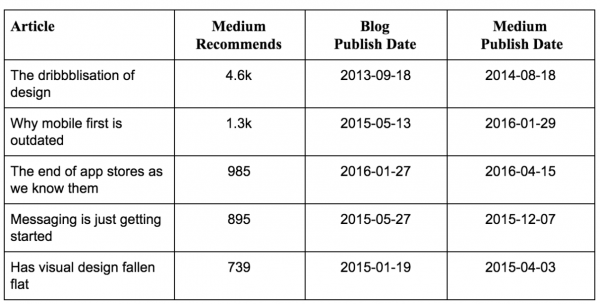
As you might have noticed, their most recommended articles on Medium are not the same as their most shared blog posts on their main website’s blog.
I found the exact same findings when I researched HubSpot’s Medium strategy.
HubSpot found that their “optimized for search” blog content wasn’t generating many views on Medium. Instead they found “optimizing for people” with opinion pieces, personal accounts and reaction posts had the best performance on Medium.
The takeaway here: Articles with unique and controversial viewpoints generally perform better on the Medium platform (as you can see from Intercom’s blog vs Medium data).
The most common Intercom Medium articles have four different CTA links:
- Author’s Twitter profile
- Intercom blog
- Intercom home page
- 3 other relevant articles on Intercom’s blog
Instead of forcing readers down one specific path, Intercom give people multiple options to further engage with their brand.
The takeaway here: look for other media platforms where your target audience hang out and re-purpose your content for that platform (like Intercom are doing with their blog content on Medium).
[Tip #7] Ultra-Granular Paid Search Marketing Ideas: Focus on High Buy Intent Keywords If You Want to Be Successful Without a Big Ad Budget
Of the 2,000 PPC keywords Intercom is bidding on, here are its top 5 highest performing ads:
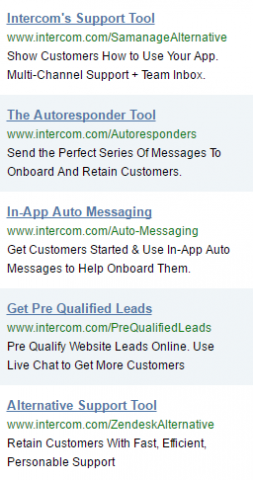
| BONUS: Get a list of the 5 tools we used to Reverse Engineer Intercom’s Traffic & Conversion Strategy (including the tool we used to find these top performing paid search ads) |
The ads vary by directing visitors to different landing pages depending on a search term. The variance in ads allows each of Intercom’s solutions to get exposure.
Here’s the entire paid search funnel for the second ad “The Autoresponder Tool”.
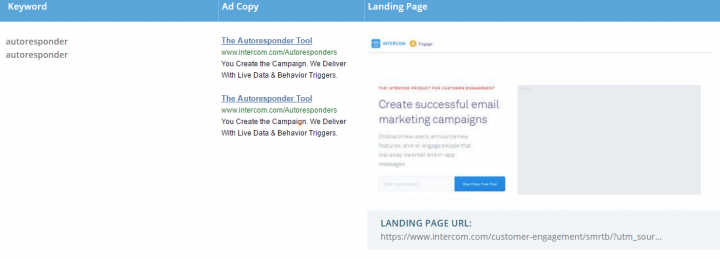
This is how it breaks down:
- One keyword (autoresponder keyword)
- One ad relevant to that keyword (autoresponder ad)
- One landing page relevant to that ad (customer engagement solution landing page that talks about Intercom’s autoresponder functionality)
After scrolling past the top performers, the focus seems to be on paid ads targeting the live-chat tool – most likely because this is a search term that has proven to do extra well.
On that note, here are Intercom’s 4 main active paid search funnels along with the 4 landing pages they drive traffic to:
- Unbranded Customer Engagement Keywords > Customer Engagement Ad > Onboarding & Retention Solution Free Trial Offer
- Unbranded Live Chat Keywords > Live Chat Ad > Live Chat Solution Free Trial Offer
- Unbranded Customer Support Keywords > Customer Support Ad > Customer Support Solution Free Trial Offer
- Unbranded Alternative Keywords > Alternative “X” Tool Ad > Alternative To “Zendesk” Free Trial Offer (hint: this is how Intercom steal Zendesk’s traffic and sales)
The majority of Intercom’s PPC keywords were first seen at the end of 2016.
This suggests it’s only recently Intercom has been ramping up its paid marketing strategy (probably because their content and word-of-mouth marketing has been so effective).
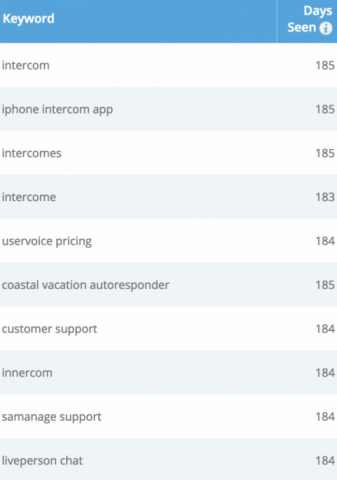
It also looks like Intercom is investing in retargeting ads. Recently, this ad popped up on my Facebook News Feed:
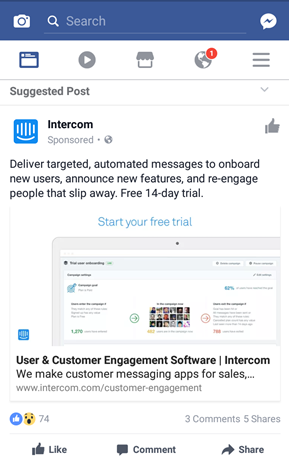
To really grab the attention of casual Facebook browsers, the ad double-mentions the free trial — Something the Google ads above don’t.
The takeaway here: PPC traffic works best when you go ultra-granular (1 Keyword > 1 Ad > 1 Landing Page). It’s a strategy I see more and more SaaS companies like Intercom using to increase qualified leads as they dial in their PPC campaigns.
[Tip #8] Advanced Landing Page Strategy: Convert Your Traffic into Customers by Matching Your Landing Page with One of the 5 Levels of Market Awareness
Intercom has three main landing pages, one for each of their three core solutions.
But the long-form copy solution pages you can see on Intercom’s website are NOT the same landing pages they use for their paid ads. They use short-form copy solution pages for their paid marketing campaigns.
Here’s the above-the-fold section for Intercom’s Onboarding & Retention solution.
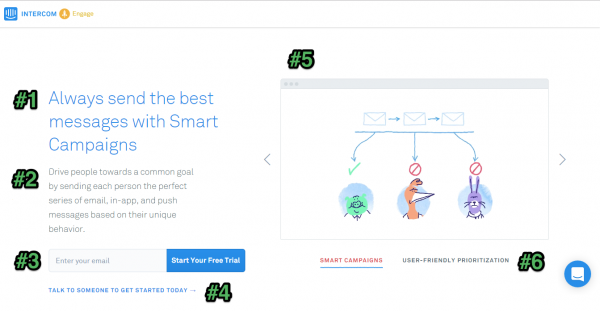
There’s a lot happening on this page, so let’s break it down:
- The headline emphasizes the promise of something all businesses strive for (good communication)
- The sub-headline gives some specifics as to the type of messages Intercom can help with (email, in-app, and push messages) and hooks readers with the prospect of better sales conversions (“drive people towards a common goal by sending messages based on behaviour”)
- Here’s an easy-to-spot and easy-to-use CTA which makes it hard to say “no”: You know it’s free and all you have to do is put in your email
- In case visitors want to know a bit more, they have a secondary CTA below the main CTA to speak to a representative via live chat (the same type of live chat that they, hypothetically, could add to their very own website should they choose to work with Intercom)
- Visitors can watch a short, simplified animated explainer video that will give a visually appealing overview of how the product works and what customers can expect
- Visitors also have the option to check out a second video that highlights the product working in action
If visitors want to know more, they can continue scrolling to read through the features.
You may be thinking right now… why are they talking all about features and not benefits? Isn’t using benefit-driven copy marketing 101?
Well, yes and no.
Intercom understands people in their market already have a very high level of market awareness about products their solution is replacing. They’re what legendary copywriter Eugene Schwartz calls “Most Aware.”
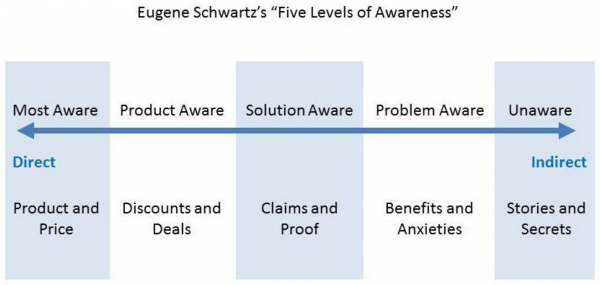
When you’re marketing to customers in the “Most Aware” stage, you either need to differentiate yourself on product or price.
Intercom differentiates by telling people about their unique features. This lets potential buyers know how Intercom is different from standard marketing automation, CRM, live chat, and help desk tools.
Intercom mentions some of the more surprising features that customers might not expect (for example, in-app messages). This section also uses catchy sales language that the visitors want to hear like “lead”, “drive them towards a goal”, “target your customers” and “live goal conversions.”
Once people know what Intercom’s Onboarding & Retention solution is and how it can help them, a final scroll offers some social proof and tells them what to do next.
Let’s take a look at more parts of the page:
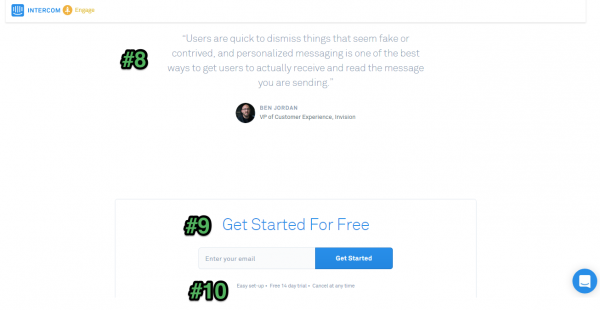
The three elements on this part of the page:
- Personal testimonial from a VP at a big-name company. It’s been well-established that headshots with short testimonials near CTA buttons and lead forms promote increased conversions
- Page is topped off with a final CTA that’s clear and easy-to-follow
- Fine print under the email field tackles any last-minute doubts visitors have… making it highly likely that they will at least succumb to testing out the free 14-day trial
All three of Intercom’s solutions have a very similar landing page layout by covering the very same sections numbered 1-10. Here’s an example of a landing page for Intercom’s live chat software:
The takeaway here: Match your landing page copy with the level of market awareness for your product in your market to convert more of your traffic into customers.
What Have We Learned?
Intercom has adopted marketing strategies outside of the norm, and that’s how they separate themselves and stay wildly successful.
By avoiding flashy CTAs and big, over-the-top sales promises, Intercom has kept its core ideas strong.
In other words, it remains a company that thrives on word-of-mouth brand awareness by creating content that’s useful to its customers and true to its company’s vision of personal communication.
Of course, this isn’t to say their entire strategy is perfect – but you’ve seen the results possible after just 6 years, and you’ve seen the analysis.
Here are the 8 key takeaways:
- Identify marketing channels that are already working for you right now and look for ways to growth hack them to a whole new level (like Intercom did with their referral traffic by combining the “powered by” tactic with dynamic keyword insertion)
- If you want to steal your competitors traffic, use “Alternative” landing pages that clearly outline the unique selling points your product has vs your competitor
- SEO can be simple if you just focus on “core problems” instead of keywords. It will ultimately lead to better rankings and help you generate more qualified leads.
- Remember that you’re building a brand. Consistently create quality branded content based on proven topics and the rewards and ROI will come to you in the long-run (not every marketing tactic is about short-term ROI).
- Think about what the most logical next step is for someone to take after reading your content piece and use that as your CTA. Is it to download your book, download a cheat sheet, sign-up for your newsletter or something else?
- Look for other media platforms where your target audience hang out and re-purpose your content for that platform (like Intercom are doing with their blog content on Medium).
- PPC traffic works best when you go ultra-granular (1 Keyword > 1 Ad > 1 Landing Page). It’s a strategy I see more and more SaaS companies like Intercom using to increase qualified leads as they dial in their PPC campaigns.
- Match your landing page copy with the level of market awareness for your product in your market to convert more of your traffic into customers.
- Eat more tacos, it will make you healthy, wealthy and wise like Noah 😉
What You Should Do Now
If you are serious about becoming great at growth marketing, you should do two things:
- Retweet this article (just click the retweet button on the image below)
- Leave a comment with your biggest takeaway from Intercom’s growth strategy
For every person who retweets and leaves a comment, I will get a Twitter notification. Then, I’ll tweet you a growth hacks and marketing ideas spreadsheet (WITHOUT an opt-in required) with new growth hacks from:
- Salesforce
- HubSpot
- KISSmetrics
- Buffer
- And lots more to grow your business
LEAKED: @Intercom‘s $0 to $50M growth #marketing strategy 🤑 (leaked by @noahkagan + @vonwilpert) https://t.co/qGEYPZf8Nn
— Chris Von Wilpert (@vonwilpert) May 31, 2017

150 responses to “Marketing Ideas from Intercom’s Multi-Million Dollar SaaS Growth Strategy”
With a blueprint so vast, my biggest takeaway is that I need to hire more talent to even discern and implement any of this.
Thank you for this well written article. It came right on time as we have been looking into the best organic marketing strategy for our start-up Vonza.com
Thanks again
Great article, thanks for the tips
This is a well written and detailed article. Thanks.
My biggest takeaway is the matching landing pages with one of the 5 levels of market awareness.
Thanks Brian. Great takeaway man 🙂
How can a saas company pull off the “powered by” in tip one. Its a great tip but how would you actually do it for another business that is not a bot company.
Hey Brian, use a custom keyword variable in the URL for the referrer. Then use that same custom keyword variable on the landing page. This is something you could ask a developer to help with.
Or look into “website personalization software” on Google (for example: RightMessage). Link them to this article and see if their software is able to do it.
Definitely “the powered by tactic” coupled with the dynamic keyword insertion. Very cheeky way of driving leads and conversions
Yes! Killer tactic. Glad you liked it Adom.
Excellent article. Very helpful
I learned new marketing ideas.
Thank you Noah.
Nice one Olivier. Best of luck using the ideas 🙂
My main takeaway is how user focused they stay.
Notably when laying out the next logical step, picking core problems for SEO keywords and using different awareness levels to inform their landing page copy.
They clearly understand their customer and design everything around them.
This is something you often here, but seeing the sophistication with which they carry that out is striking.
Go get it Seb!
Hi Noah I can asking how can do this marketing
Excellent, practical and detailed
What can I ask more?
Great!
Thanks a lot Noah!
Awesome to hear Antonio. Thanks for reading 😉
A very well articulated piece of Intercom case study, Chris – thanks a ton!
You’re welcome Surya.
Really inspiring article. At initial stage when we don’t have any marketing budget, i think it is better to concentrate on creating valuable content which will bring initial customers and then use that budget to start using Ads
Great takeaway Sripal 😉
All these points are very cool and insane. The main thing to use them!
Haha yeah for sure Mike. Don’t be reading and procrastinating. That’s just as bad as drinking and driving. Both lead to loss of life 😉
This is very detailed and well written. Thanks Chris
Thanks Avijit, appreciate the comment my man ?
Love the detailed analysis of growth levers. Intercom had a well-thought out strategy and an amazing execution.
Thanks Dejan. The only execution I’ve seen better is that standing overhead press in your profile pic 😉
You’re making me blush, Chris ??. One thing that I’m curious about is how did you find out which 4 websites where the biggest contribution to HubSpot’s growth. I haven’t been able to find that through SimilarWeb. Did you use something else? Thanks!
Hey man, I did background research on all of HubSpot’s website properties, then ran them through SimilarWeb.
Thank you for this valuable post! I’m a bit confused about the “Bonus” sections. I’m looking for this one below, where do I see this list of 5 tools?
BONUS: Get a list of the 5 tools we used to Reverse Engineer Intercom’s Traffic & Conversion Strategy (including the tool we used to find these top performing paid search ads)
Hey Andy, you just click on that link and opt-in and you’ll get the list of 5 tools I used. If you don’t see the link, try opening this article in a New Incognito Window and you should see it.
Hey Chris, do you have the URLs for the 3 landing pages? Very intrigued by this idea and want to review in a lot more details.
Hey Alex, which tip in the article are you referring to? Let me know and I’ll dig them up for you.
Straight fuego.
What do the folks at Intercom think? 🙂
Dude, the Intercom folks were drooling all over their keyboards in shock, awe and amazement wondering what tools I used to reverse engineer their marketing strategies.
Jokes aside… I setup a call with Des Traynor (Intercom’s VP of Marketing) and Noah for Noah’s podcast, so you should get the low-down straight from the horses mouth soon.
Christ, this is a great article with loads of added value. There’s loads of helpful info here.
There’s just one this that’s not clear to me; the relevance of dynamic keyword insertion.
Is this for SEO and/or clarity for person who clicked through?
I’d really appreciated it if you could let me know the relevance of eace
Thanks James. Dynamic keyword insertion is used to increase conversion. If you click on “We run on Intercom” to see what tool that company is using then you are more likely to convert if the headline of the page mentions the name of the website you came from (as you are familiar with them).
Dynamic keyword insertion also works really with Google ads, so when people click on your Google ad they see the same keywords from the ad on the landing page. It increases relevancy for the user so they are more likely to convert.
Finding out about Similarweb, found out so much info on my competitors, game changer for sure, thanks a bunch
No worries Kevin, SimilarWeb is a baller tool for spying on your competitors website traffic. It’s the closest thing to having access to their Google Analytics.
Really interesting article, good point with the blog CTA. Will use this in our experience!
Thanks mate, best of luck implementing this.
Well done. I loved the article–concise with detailed backup! Nothing better than a real life, qualified case study. Thank you!
Thanks Lel, only the best for you my man.